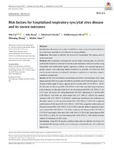Risk factors for hospitalized respiratory syncytial virus disease and its severe outcomes
Cai, Wei
Buda, Silke
Schuler, Ekkehard
Hirve, Siddhivinayak
Zhang, Wenqing
Haas, Walter
Introduction
Respiratory syncytial virus (RSV) is a major cause of hospital admission for acute lower respiratory tract infection in young children.
Objectives
We aimed to identify risk factors for hospitalized RSV disease and its severe outcomes.
Methods
We conducted a retrospective cohort study analyzing data of a ICD‐10‐code‐based hospital surveillance for severe acute respiratory infections (SARI). Using univariable and multivariable logistic regression analysis, we assessed age‐group, gender, season, and underlying medical conditions as possible risk factors for RSV and its severe outcomes including ICU admission, application of ventilator support, and death, respectively.
Results
Of the 413 552 patients hospitalized with SARI in the database, 8761 were diagnosed with RSV from week 01/2009 to 20/2018 with 97% (8521) aged <5 years. Among children aged <5 years, age‐groups 0‐5 months (OR: 20.29, 95% CI: 18.37‐22.41) and 6 months‐1 year (OR: 4.59, 95% CI: 4.16‐5.06), and underlying respiratory and cardiovascular disorders specific to the perinatal period (OR: 1.32, 95% CI: 1.11‐1.57) were risk factors for being diagnosed with RSV. Age‐group 0‐5 months (OR: 2.39, 95% CI: 1.45‐3.94), low birth weight (OR: 6.77, 95% CI: 1.28‐35.71), preterm newborn (OR: 6.71, 95% CI: 2.19‐20.61), underlying respiratory and cardiovascular disorders specific to the perinatal period (OR: 4.97, 95% CI: 3.36‐7.34), congenital malformation of the heart (OR: 3.65, 95% CI: 1.90‐7.02), congenital malformation of the great vessels (OR: 3.50, 95% CI: 1.10‐11.18), congenital defect originating in perinatal period (OR: 4.07, 95% CI: 1.71‐9.70), cardiovascular disease (OR: 5.19, 95% CI: 2.77‐9.72), neurological disorders (OR: 6.48, 95% CI: 3.76‐11.18), blood disease (OR: 3.67, 95% CI: 1.98‐6.79), and liver disease (OR: 14.99, 95% CI: 1.49‐150.82) contributed to ICU admission in RSV cases.
Conclusions
Using ICD‐10‐based surveillance data allows to identify risk factors for hospitalized RSV disease and its severe outcomes, and quantify the risk in different age‐groups.
Files in this item

